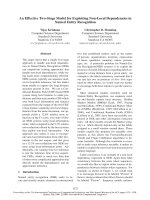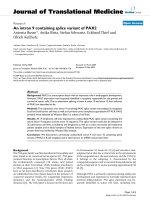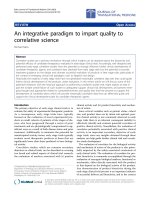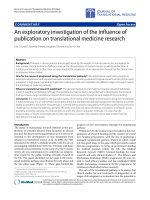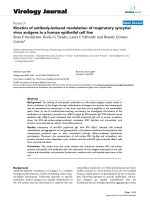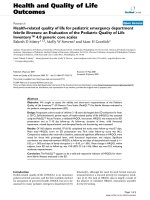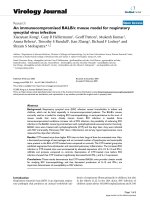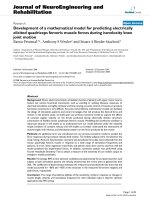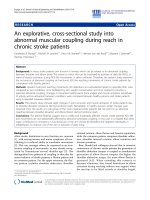báo cáo hóa học:" An immunocompromised BALB/c mouse model for respiratory syncytial virus infection" pdf
Bạn đang xem bản rút gọn của tài liệu. Xem và tải ngay bản đầy đủ của tài liệu tại đây (1.96 MB, 8 trang )
BioMed Central
Page 1 of 8
(page number not for citation purposes)
Virology Journal
Open Access
Research
An immunocompromised BALB/c mouse model for respiratory
syncytial virus infection
Xiaoyuan Kong
1
, Gary R Hellermann
1
, Geoff Patton
1
, Mukesh Kumar
1
,
Aruna Behera
1
, Timothy S Randall
1
, Jian Zhang
1
, Richard F Lockey
2
and
Shyam S Mohapatra*
1,2
Address:
1
Department of Internal Medicine, Division of Allergy and Immunology, Joy McCann Culverhouse Airway Disease Research Center,
University of South Florida College of Medicine USA and
2
James A. Haley VA Hospital, Tampa, FL, USA
Email: Xiaoyuan Kong - ; Gary R Hellermann - ; Geoff Patton - ;
Mukesh Kumar - ; Aruna Behera - ; Timothy S Randall - ;
Jian Zhang - ; Richard F Lockey - ; Shyam S Mohapatra* -
* Corresponding author
Abstract
Background: Respiratory syncytial virus (RSV) infection causes bronchiolitis in infants and
children, which can be fatal, especially in immunocompromised patients. The BALB/c mouse,
currently used as a model for studying RSV immunopathology, is semi-permissive to the virus. A
mouse model that more closely mimics human RSV infection is needed. Since
immunocompromised conditions increase risk of RSV infection, the possibility of enhancing RSV
infection in the BALB/c mouse by pretreatment with cyclophosphamide was examined in this study.
BALB/c mice were treated with cyclophosphamide (CYP) and five days later, they were infected
with RSV intranasally. Pulmonary RSV titers, inflammation and airway hyperresponsiveness were
measured five days after infection.
Results: CYP-treated mice show higher RSV titers in their lungs of than the untreated mice. Also,
a decreased percentage of macrophages and an increased number of lymphocytes and neutrophils
were present in the BAL of CYP-treated mice compared to controls. The CYP-treated group also
exhibited augmented bronchoalveolar and interstitial pulmonary inflammation. The increased RSV
infection in CYP-treated mice was accompanied by elevated expression of IL-10, IL-12 and IFN-γ
mRNAs and proteins compared to controls. Examination of CYP-treated mice before RSV
infection showed that CYP treatment significantly decreased both IFN-γ and IL-12 expression.
Conclusions: These results demonstrate that CYP-treated BALB/c mice provide a better model
for studying RSV immunopathology and that decreased production of IL-12 and IFN-γ are
important determinants of susceptibility to RSV infection.
Introduction
Respiratory syncytial virus (RSV) is an important respira-
tory pathogen that produces an annual worldwide epi-
demic of respiratory illness primarily in children, but also
in the elderly [1,2]. In the USA alone, RSV infection of
children causes about 100,000 hospitalizations and 4,500
Published: 8 February 2005
Virology Journal 2005, 2:3 doi:10.1186/1743-422X-2-3
Received: 6 December 2004
Accepted: 8 February 2005
This article is available from: />© 2005 Kong et al; licensee BioMed Central Ltd.
This is an Open Access article distributed under the terms of the Creative Commons Attribution License ( />),
which permits unrestricted use, distribution, and reproduction in any medium, provided the original work is properly cited.
Virology Journal 2005, 2:3 />Page 2 of 8
(page number not for citation purposes)
deaths annually (MMWR, 1996). RSV commonly precipi-
tates bronchiolitis and exacerbates asthma but is also
associated with severe life threatening respiratory infec-
tions in individuals with coronary artery disease or who
are immunocompromised [3-6]. At the molecular level,
RSV infection up-regulates the expression of several
cytokines and chemokines, such as IL-1β, IL-6, IL-8, TNF-
α, MIP1α, RANTES, and the adhesion molecule ICAM-1,
ET-1, LTB4 and LTC4/D4/E4 [7-13]. Furthermore, ele-
vated levels of cytokines and chemokines have been
found in the nasal secretions of naturally RSV-infected
children and of artificially-infected adults [14-17]. Defects
in IL-12 and IFN-α production have been associated with
severe RSV disease [18].
Despite progress in our understanding of immunopathol-
ogy, the lack of a suitable animal model, with pathophys-
iology similar to humans, allowing appropriate virology,
immunology, pathology and toxicology testing, has hin-
dered the development of prophylactic and therapeutic
interventions against RSV infection [19]. The pathology of
RSV infection has been examined in a number of animals
including primates, cotton rats, mice, calves, guinea pigs,
ferrets and hamsters [19]. The choice of an experimental
model is governed by the specific manifestation of the dis-
ease. The development of multiple animal models reflects
the multifaceted nature of human RSV disease, in which
clinical manifestations and sequelae depend upon age,
genetic makeup, immunologic status and concurrent dis-
ease status of the individual [19]. Currently there is no sin-
gle animal model that duplicates all forms of RSV disease.
While cotton rats provide a good model for toxicologic
evaluations, mice are considered advantageous for immu-
nology and vaccine development. Furthermore, in mice
the importance of IFN-γ, IL-6, IL-10 and IL-13 has been
described [20-24]. The mouse provides an excellent
model for human RSV infection because of the following:
(a) the mouse is the best-characterized animal model, and
experiments can be performed in this model in a cost- and
time-effective manner, (b) a wide array of immunological
reagents is available for studies in this model, and (c) the
A2 strain of human RSV administered intranasally readily
infects lungs of mice, and exhibits a time course of infec-
tion, pathology and resolution similar to that seen in
humans [25]. Treatment of mice with the anti-RSV com-
pound ribavirin decreases RSV titers in the lungs [26].
Depending upon the amount of RSV administered, the ill-
ness in micemay range from mild pneumonitis of the lung
to weight loss [27].
Healthy BALB/c mice are semi-permissive to RSV and
develop only limited inflammation and airway reactivity.
Based on the reports that deficiency in IL-12 and IFN pro-
duction increases severity of RSV disease, we hypothesized
that rendering mice immunocompromised, will improve
permissiveness to RSV and provide a better model for RSV
infection. To test this hypothesis, BALB/c were treated
with cyclophosphamide, infected with RSV, and charac-
terized in terms of viral infectivity and pathology, immu-
nology, and immunohistology. The results show that
cyclophosphamide temporarily decreases IL-12 produc-
tion and thus augments viral replication and the immun-
opathology of RSV disease.
Materials and Methods
Animals
Female six-week old BALB/c mice were purchased from
Jackson Laboratory (Bar Harbor, ME) and maintained in
a pathogen-free environment. All procedures were
reviewed and approved by the University of South Florida
Committee on Animal Research.
Cyclophosphamide treatment
Cyclophosphamide (CYP; Sigma, St. Louis, MO) was
administered to mice intraperitoneally (i.p.) at a single
dose of 100 mg per kg five days prior to RSV infection.
RSV infection, weight determination and tissue collection
The A2 strain of human RSV (American Type Culture Col-
lection, Manassas, VA) was propagated in Hep-2 cells
(ATCC) in a monolayer culture as previously described
(Behera et al., 1998). Mice were infected intranasally with
5 × 10
5
PFU of RSV in a volume of 50 µl five days after
treatment with CYP. One set of animals was monitored
for weight loss at days 5, 10, 15 and 22 following CYP
treatment (0, 5, 10 and 17 days after RSV infection). A sec-
ond set of animals was sacrificed five days after infection
and their lungs were removed for determination of RSV
titers, cytokine levels and histopathology.
RSV plaque assay
HEp-2 cells (5 × 10
5
/well) in 6-well plates were infected
with 5 × 10
5
pfu RSV per well for 2 hours at 37°C. The RSV
was removed and the wells were overlaid with 1.5 ml of
growth medium containing 0.8% methylcellulose. The
cells were then incubated at 37°C for 72 hours, after
which the overlay was removed. Following incubation,
the cells were fixed in cold 80% methanol for 3 hours,
blocked with 1 % horse serum in PBS at 37°C for 30 min,
then incubated with anti-RSV monoclonal antibody
(NCL-RSV 3, Vector Laboratories, Burlingame, CA)
diluted 1:400 for 1 hour at 37°C. Secondary antibody
staining and substrate reactions were performed using the
Vectastain ABC Kit (Vector Laboratories) and diami-
nobenzidine in H
2
O
2
(Pierce, Rockford, IL) was used as a
chromagen. The plaques were enumerated by microscopy
and the results were expressed as mean ± standard error of
the mean.
Virology Journal 2005, 2:3 />Page 3 of 8
(page number not for citation purposes)
Determination of airway hyperresponsiveness (AHR)
AHR was measured in unrestrained mice using a whole
body plethysmograph (Buxco, Troy, NY), as previously
described (Schwarze et al., 1997) and expressed as
enhanced pause (Penh). Groups of mice (n = 4) were
exposed for 5 min to nebulized PBS and subsequently to
increasing concentrations (6, 12, 25 and 50 mg/ml) of
nebulized methacholine (MCh; Sigma, St, Louis, MO) in
PBS using an ultrasonic nebulizer. After nebulization,
recordings were taken for 5 minutes. Penh values were
averaged and expressed as a percentage of baseline Penh
values obtained following PBS exposure.
Immunohistochemical analysis
Mouse lungs were rinsed with intratracheal injections of
PBS then perfused with 10 % neutral buffered formalin.
Lungs were removed, paraffin-embedded, sectioned at 20
µm and stained with hematoxylin and eosin (H & E). A
semi-quantitative evaluation of inflammatory cells in the
lung sections was performed as previously described
(Kumar et al., 1999). Whole lung homogenates were pre-
pared using a TissueMizer and assayed for cytokines IL-10,
IL-12 and IFN-γ by ELISA (R & D Systems, Minneapolis
MN), following the manufacturer's directions. The results
are expressed as cytokine amount in picograms per gram
of lung (pg/g).
Detection of RSV and cytokines in the lungs by RT-PCR
Total cellular RNA was isolated from lung tissue using
TRIZOL reagent (Life Technologies, Gaithersburg, MD).
Forward and reverse primers used were as follows: RSV-N
forward: 5'-GCG ATG TCT AGG TTA GGA AGA A-3';
reverse: 5'-GCT ATG TCC TTG GGT AGT AAG CCT-3';
mouse IFN-γ Forward: 5'-GCT CTG AGA CAA TGA ACG
CT-3'; reverse: 5'-AAA GAG ATA ATC TGG CTG TGC-3';
mouse IL-10 forward: 5'-GGA CTT TAA GGG TTA CTT
GGG TTG CC-3'; reverse: 5'-CAT TTT GAT CAT CAT GTA
TGC TTC T-3'; mouse IL-12 forward: 5'-CAG TAC ACC
TGC CAC AAA GGA -3'; reverse: 5'-GTG TGA CCT TCT
CTG CAG ACA -3' and β-actin forward: 5'-GAC ATG GAG
AAG ATC TGG CAC-3'; reverse: 5'-TCC AGA CGC AGG
ATG GCG TGA -3'. All PCRs were denatured at 95°C for 1
min, annealed at 56°C for 30 sec, and extended at 72°C
for 1 min for 25–35 cycles. All amplifications were done
in triplicate and repeated three times. The PCR products
were separated by agarose gel electrophoresis and quanti-
fied using Advanced Quantifier Software (BioImage, Ann
Arbor, MI).
Cell enumeration of bronchoalveolar lavage fluid
Bronchoalveolar lavage (BAL) fluid was collected and dif-
ferential cell counts were performed as previously
described (Kumar et al., 1999). Briefly, BAL was centri-
fuged and the cell pellet was suspended in 200 µl of PBS
and counted using a hemocytometer. The cell suspensions
were then centrifuged onto glass slides using a cytospin
centrifuge at 1000 rpm for 5 min at room temperature.
Cytocentrifuged cells were air dried and stained with a
modified Wright's stain (Leukostat, Fisher Scientific,
Atlanta, GA) which allows differential counting of mono-
cytes and lymphocytes. At least 300 cells per sample were
counted by direct microscopic observation.
Statistical analysis
Values for all measurements were expressed as mean ± SD
or SEM. The data were analyzed by ANOVA. Paired and
unpaired results were compared by a Wilcoxon rank sum
test or Mann-Whitney test respectively. Differences
between groups were considered significant at p < 0.05.
Results
Cyclophosphamide treatment augments RSV infection in
mice
Groups of mice were injected i.p. with a single dose of
CYP or PBS and five days later infected with RSV. Five days
after infection, RSV titers in one group of mice were meas-
ured by plaque assay of lung homogenates (Fig. 1A). The
mice pretreated with CYP produced significantly more (p
< 0.01) RSV plaques compared to the PBS control group.
Weight loss is a clinical correlate of RSV infection, there-
fore weights were measured in a parallel group of mice on
day 5, 10, 15, and 22 after CYP treatment (day 0, 5, 10 and
17 after RSV infection) (Fig. 1B). CYP treatment alone
resulted in a weight loss or reduced weight gain compared
to PBS, but the RSV-infected, CYP-treated mice lost signif-
icantly more weight than those exposed to RSV alone p <
0.05; †.p < 0.01(vs. RSV) or PBS (p < 0.01 vs. Control).
Pretreatment with CYP resulted in increased weight loss in
the RSV-infected mice through day 15 and reduced weight
gain at day 22 indicating that cyclophosphamide treat-
ment exacerbated the pathology of RSV infection.
Cyclophosphamide pretreatment increases RSV-inducible
lung inflammation
To examine whether CYP treatment increases inflamma-
tory effects in the lungs of RSV-infected mice, we deter-
mined airway hyperresponsiveness (AHR), cellular
infiltration into the lung and lung histopathology.
Groups of BALB/c mice either infected with RSV alone or
treated with cyclophosphamide (CYP) prior to infection
were lavaged and cells in the fluid were centrifuged onto
slides. BAL cells were stained with Leukostat. Cells were
counted from 4 different slides from each group in a
blinded fashion. Cell counts were plotted as percentage of
total cells (Fig. 2A). There was a decrease in the number of
macrophages and increases in lymphocyte and neutrophil
numbers following RSV infection that was enhanced by
prior treatment with CYP. To analyze the extent of lung
pathology, lungs were paraffin embedded, sectioned and
stained with hemotoxylin-eosin (HE). The lung sections
Virology Journal 2005, 2:3 />Page 4 of 8
(page number not for citation purposes)
from RSV-infected, CYP-treated mice (Fig. 2C, a & b)
showed significantly greater inflammation than lungs
from mice given RSV alone (Fig. 2C, c & d). The RSV-
infected groups showed greater inflammation than unin-
fected control mice (Fig. 2C e & f).
Increased RSV infection in CYP-treated BALB/c mice is
associated with increased production of
immunoregulatory cytokines
To examine the cytokine profile in lungs from RSV-
infected mice with or without CYP treatment, the gene
expression of IL-10, IFN-γ and IL-12 was measured by RT-
PCR. Gel profiles and densitometric analyses are shown in
Fig. 3A and 3B. The results show that mice infected with
RSV after CYP treatment have increased mRNA expression
for all of three cytokines compared to control mice or
mice infected with RSV alone. To determine whether mice
treated with CYP and infected with RSV do produce more
of these proteins, cytokines were measured by ELISA on
homogenates prepared from whole lungs. IL-10 (p < 0.05
vs. PBS), IL-12 (p < 0.05 vs. RSV) and IFN-γ (p < 0.05 vs.
PBS) levels were significantly higher in the CYP-treated
group than the control group (Fig. 4A–C).
Cyclophosphamide treatment causes a transient reduction
in IL-12 and IFN-
γ
expression
To examine the mechanism underlying the increased RSV
infection in CYP-treated animals, the levels of two
cytokines that exert antiviral activity, IL-12 and IFN-γ was
measured after treatment with CYP (Fig. 5). Mice were sac-
rificed on days 1, 2, 4, 6 after treatment and IL-12 and
IFN-γ protein levels were measured in whole lung
homogenates by ELISA. Untreated BALB/c mice were used
as controls. Treatment with CYP gradually decreased both
IL-12 (p < 0.05) and IFN-γ (p < 0.01 vs. Control) until day
4. These results show that decreased production of IL-12
and IFN-γ may play a role in the observed increase in RSV
infection in CYP-treated mice.
Discussion
The main focus of this study has been to establish and
characterize an immunocompromised mouse model for
studying RSV infection. Mice are only semi-permissive to
RSV infection, yet can serve as a useful model for immu-
nological studies. Compared to the traditional BALB/c
mouse model, the use of cyclophosphamide to create an
immunocompromised condition provides an effective
(A) tbfCYP increases RSV titer in the lungs of BALB/c miceFigure 1
(A) CYP increases RSV titer in the lungs of BALB/c mice. Mice were treated with CYP (100 mg/kg, i.p.) or PBS and 5
days later infected with RSV (50 µl i.n. twice, 10
6
PFU/ mouse). Animals were sacrificed on day 4 and RSV titers were measured
in whole lung homogenates by RSV plaque assay. (n = 4 for each group; § P < 0.01 vs PBS group). (B) Cyclophosphamide
affects body weight. Mice (n = 4) were infected with RSV alone or were treated with CYP (100 mg/kg i.p.) prior to infection.
Body weights were measured on day 1, 5, 10, 15, and 22 after treatment. Bars represent means ± SEM. (* P < 0.05; †. P < 0.01
vs RSV); ‡ P < 0.05; § P < 0.01 vs control).
CYP+RSV RSV CYP PBS
Body Weight Changes (g)
∗§
∗
++
-1.5
-1
-0.5
0
0.5
1
1.5
2
2.5
Day 5 Day 10
Day 15 Day 22
A
R
S
V
P
l
a
q
u
e
s
x
1
0
3
/
g
o
f
l
u
n
g
PBS+RSV CYP+RSV
§
0
40
80
120
160
B
Virology Journal 2005, 2:3 />Page 5 of 8
(page number not for citation purposes)
(A) BAL cell differential of RSV-infected miceFigure 2
(A) BAL cell differential of RSV-infected mice. Mice were treated with cyclophosphamide (CYP) or vehicle 5 days
before infection with RSV. Animals were sacrificed on day 4 postinfection and BAL was performed. Following cytocentrifuga-
tion, BAL cells were stained with Leukostat and counted from 4 different slides from each group in a blinded fashion. Cell
counts as percentage of total were plotted. (B) Measurement of airway hyperrresponsiveness (AHR). Mice treated as
above were tested for AHR by methacholine challenge in a plethysmograph. AHR is expressed as PENH, percent of control.
(C) Lung histopathology. Mice were infected with RSV alone (C and D) or treated with cyclophosphamide (A and B)
prior to RSV infection. The third group of mice was not exposed to RSV (E and F). Animals were sacrificed on day 5 and their
lungs removed and sectioned. Paraffin-embedded lung sections were stained with hematoxylin-eosin.
% Cells
0
20
40
60
80
100
120
Control
RSV
Cyp+RSV
A
mac lym neu eos
Cell Types
Methacholine (mg/ml)
%Penh
0
100
200
300
400
500
6.25 12.5 25 50
PBS
CYP
RSV
CYP+RSV
B
CYP+RSV RSV PBS
a
b
c
d
e
f
C
Virology Journal 2005, 2:3 />Page 6 of 8
(page number not for citation purposes)
means of augmenting RSV replication and disease.
Pretreatment of BALB/c mice with CYP results in RSV titers
in the lungs of these immunocompromised mice that are
increased significantly compared to the group infected
with RSV without cyclophosphamide treatment. These
results are consistent with an earlier study in the cotton rat
model [28]. In another study, a high titer RSV inoculum
(10
7
PFU/ml) was administered intranasally to old mice
and resulted in clinical illness and appreciable pathology
in the lung [25], while mice inoculated with 10
6
PFU/ml,
or less, did not exhibit symptoms of illness. Most studies
using mice as models employ lower doses of RSV because
RSV infection in humans, which induces a pneumonia-
like pulmonary inflammation, occurs typically at sub-
clinical RSV doses. The loss of body weight in CYP-treated
mice following RSV infection compared to untreated con-
trol mice confirmed that CYP-treatment increased the sus-
ceptibility to RSV infection at lower inocula. This finding
that permissiveness to RSV can be augmented by render-
ing mice immunocompromised is significant, as it
increases the utility of the mouse model for RSV infection.
Consistent with increased RSV infection, the cellular pop-
ulation in BAL fluid was altered. Especially significant are
the increases in lymphocytes and neutrophils in CYP-
treated mice compared to controls. This data is in agree-
ment with previous reports showing that RSV infection
increased lymphocyte infiltration in the lung [2]. Along
with increased cellular infiltration, lung pathology, partic-
ularly epithelial denudation and goblet cell hyperplasia, is
also markedly increased.
Expression of IL-10, IL-12 and IFN-γ was examined to
determine if RSV-induced changes in the levels of these
cytokines in the lungs of CYP-treated mice played a role in
the increased lung immunopathology. RSV-infected CYP-
treated mice exhibited significantly increased expression
of these cytokines at the protein and mRNA level in agree-
ment with previous observations that RSV infection
induced enhanced expression of Th1 and Th2 cytokines
[22,29]. Other studies have shown that IFN-γ can induce
production of IL-12 in a self-activating loop, by activating
macrophages which produce IL-12 [30].
Although CYP treatment is known to induce an immuno-
suppressed condition, the mechanism is unclear. The
results of cytokine analysis on days 1 to 5 after cyclophos-
phamide treatment indicated that IL-12 and IFN-γ were
reduced and the reduction was highest on days four and
two, respectively. These results suggest that the ability of
cells to produce these cytokines at the time of RSV infec-
tion is an important determinant of the magnitude of
infection in terms of increased RSV replication and titer.
Impairment in IL-12 and IFN-γ production at the key
moment of acute infection leads to rapid viral replication
and subsequent pathology. In a previous report we
demonstrated the importance of IFN-γ by artificially
increasing IFN-γ levels and showing that viral titers were
decreased because of the induction of 2'-5'oligoadenylate
synthetase which activates RNase L to degrade viral RNA
[31]. Also, studies in humans have suggested that individ-
uals lacking IFN-α or IL-12 are at a higher risk of severe
RSV disease. Thus, down-regulation of the production of
these cytokines is a likely factor underlying the observed
Detection of RSV and cytokines in the lungs of BALB/c miceFigure 3
Detection of RSV and cytokines in the lungs of BALB/c mice. (A) RSV-N and IL-10, IL-12, IFN-γ and β-actin were
checked by RT-PCR. Mice were infected with RSV alone or treated with CYP prior to infection. The third group was unin-
fected (PBS) as control. Animals were sacrificed on day 5, their lungs removed and RNA was isolated and used in RT-PCR
assay. (B) Densitometric analysis of the band densities from part A. Relative intensity refers to the ratio of the inten-
sity of each cDNA product to that of β-actin.
RSV (N)
β-actin
B
Relative
Intensity
RSV IL-10 IL-12 IFN-γ
0
0.2
0.4
0.6
0.8
1.0
CYP+RSV
RSV
A
IL-10
IL-12
IFN-γ
12 345 6
RSV + Cyp RSV PBS
Virology Journal 2005, 2:3 />Page 7 of 8
(page number not for citation purposes)
enhancement of RSV infection by cyclophosphamide
treatment.
In conclusion, the results of this study demonstrate that
cyclophosphamide treatment of BALB/c mice renders
them more susceptible to RSV infection as revealed by
increased RSV titers in the lung and decreased body
weight. The mechanism of this increase in infection
involves transient down regulation of IFN-γ and IL-12
induced by cyclophosphamide treatment.
Competing Interests
The author(s) declare that they have no competing
interests.
Authors' Contributions
XK, BAL and cell enumeration; GH, data analysis; GP,
AHR, RT-PCR; MK, RSV infection and assay, tissue collec-
tion, RT-PCR; AB, cyclophosphamide treatment, tissue
collection, ELISAs; TSR, immunohistochemistry; JZ, cell
culture and virus preparation; RFL, experimental design
and analysis; SSM, project design, experimental analysis
and data interpretation.
Acknowledgements
This study was supported by a VA Merit Review Award and by an American
Heart Association (Florida Affiliate) research grant to SSM, and by the Joy
McCann Culverhouse Endowment to the Division of Allergy and Immunol-
ogy Airway Disease Research Center.
References
1. Behera AK, Kumar M, Matsuse H, Lockey RF, Mohapatra SS: Respi-
ratory syncytial virus induces the expression of 5-lipoxygen-
ase and endothelin-1 in bronchial epithelial cells. Biochem
Biophys Res Commun 1998, 251(3):704-9.
2. Kumar M, Behera AK, Matsuse H, Lockey RF, Mohapatra SS: Intra-
nasal IFN-gamma gene transfer protects BALB/c mice
CYP-treated BALB/c mice produce higher levels of Th1 and Th2 cytokinesFigure 4
CYP-treated BALB/c mice produce higher levels of
Th1 and Th2 cytokines. Mice were infected with RSV
alone or were treated with cyclophosphamide prior to infec-
tion. The third group of mice received no virus (PBS only) as
control. Animals were sacrificed on day 5 and their lungs
removed. Whole lung homogenates were prepared and cyr-
tokines were measured by ELISA. Results are given as mean
± SEM (n = 4 for each group). (A) CYP-pretreated mice pro-
duce higher IL-10 in the lungs. (‡ P < 0.05 vs. PBS). (B) IL-12
was higher in CYP-treated mice. (§ P < 0.01 vs. PBS. * P <
0.05 vs. RSV). (C) IFN-γ was higher in CYP-treated mice. (* P
< 0.05 vs. RSV; ‡ P < 0.05 vs. PBS).
P
g
/
g
l
u
n
g
Pg/ g lung
P
g
/
g
l
u
n
g
IL-10
0
200
400
600
§
IL-12
0
40
80
120
IFN-γ
0
2000
4000
6000
CYP+RSV RSV
PBS
A
B
C
∗
∗∗
∗ ‡
‡
∗
∗∗
∗
Changes in IL-12 and IFN-γ levels over time in CYP-treated miceFigure 5
Changes in IL-12 and IFN-γ levels over time in CYP-
treated mice. Mice were treated with cyclophosphamide at
100 mg/kg i.p. Animals were sacrificed on day 1, 2, 4, 6 after
treatment and their lungs removed. Whole lung homoge-
nates were prepared and IL-12 (A) and IFN-γ (B) were
measured by ELISA. Untreated mice were used as control.
Results are shown as mean ± SEM (n = 2; ‡ P < 0.05; § P <
0.01 vs. control).
I
L
-
1
2
P
g
/
g
l
u
n
g
IFN-γ Pg/g lung
Day
‡§
§
0
50
100
150
200
1
§
‡
0
50
100
150
200
250
246C
Publish with BioMed Central and every
scientist can read your work free of charge
"BioMed Central will be the most significant development for
disseminating the results of biomedical research in our lifetime."
Sir Paul Nurse, Cancer Research UK
Your research papers will be:
available free of charge to the entire biomedical community
peer reviewed and published immediately upon acceptance
cited in PubMed and archived on PubMed Central
yours — you keep the copyright
Submit your manuscript here:
/>BioMedcentral
Virology Journal 2005, 2:3 />Page 8 of 8
(page number not for citation purposes)
against respiratory syncytial virus infection. Vaccine 1999,
18(5–6):558-67.
3. Gollob JA, Veenstra KG, Mier JW, Atkins MB: Agranulocytosis and
hemolytic anemia in patients with renal cell cancer treated
with interleukin-12. J Immunother 2001, 24(1):91-8.
4. Le HN, Lee NC, Tsung K, Norton JA: Pre-existing tumor-sensi-
tized T cells are essential for eradication of established
tumors by IL-12 and cyclophosphamide plus IL-12. J Immunol
2001, 167(12):6765-72.
5. Schwarze J, Hamelmann E, Bradley KL, Takeda K, Gelfand EW: Res-
piratory syncytial virus infection results in airway hyperre-
sponsiveness and enhanced airway sensitization to allergen.
J Clin Invest 1997, 100(1):226-33.
6. Sobel DO, Ahvazi B, Jun HS, Chung YH, Yoon JW: Cyclophospha-
mide inhibits the development of diabetes in the diabetes-
prone BB rat. Diabetologia 2000, 43(8):986-94.
7. Arnold R, Werner F, Humbert B, Werchau H, Konig W: Effect of
respiratory syncytial virus-antibody complexes on cytokine
(IL-8, IL-6, TNF-alpha) release and respiratory burst in
human granulocytes. Immunology 1994, 82(2):184-91.
8. Becker S, Quay J, Soukup J: Cytokine (tumor necrosis factor, IL-
6, and IL-8) production by respiratory syncytial virus-
infected human alveolar macrophages. J Immunol 1991,
147(12):4307-12.
9. Behera AK, Matsuse H, Kumar M, Kong X, Lockey RF, Mohapatra SS:
Blocking intercellular adhesion molecule-1 on human epi-
thelial cells decreases respiratory syncytial virus infection.
Biochem Biophys Res Commun 2001, 280(1):188-95.
10. Bitko V, Velazquez A, Yang L, Yang YC, Barik S: Transcriptional
induction of multiple cytokines by human respiratory syncy-
tial virus requires activation of NF-kappa B and is inhibited
by sodium salicylate and aspirin. Virology 1997, 232(2):369-78.
11. Elias JA, Zheng T, Einarsson O, Landry M, Trow T, Rebert N, Panuska
J: Epithelial interleukin-11. Regulation by cytokines, respira-
tory syncytial virus, and retinoic acid. J Biol Chem 1994,
269(35):22261-8.
12. Garofalo R, Mei F, Espejo R, Ye G, Haeberle H, Baron S, Ogra PL,
Reyes VE: Respiratory syncytial virus infection of human res-
piratory epithelial cells up-regulates class I MHC expression
through the induction of IFN-beta and IL-1 alpha. J Immunol
1996, 157(6):2506-13.
13. Noah TL, Becker S: Respiratory syncytial virus-induced
cytokine production by a human bronchial epithelial cell line.
Am J Physiol 1993, 265(5 Pt 1):L472-8.
14. Bonville CA, Rosenberg HF, Domachowske JB: Macrophage
inflammatory protein-1alpha and RANTES are present in
nasal secretions during ongoing upper respiratory tract
infection. Pediatr Allergy Immunol 1999, 10(1):39-44.
15. Hornsleth A, Loland L, Larsen LB: Cytokines and chemokines in
respiratory secretion and severity of disease in infants with
respiratory syncytial virus (RSV) infection. J Clin Virol 2001,
21(2):163-70.
16. Noah TL, Becker S: Chemokines in nasal secretions of normal
adults experimentally infected with respiratory syncytial
virus. Clin Immunol 2000, 97(1):43-9.
17. Saito T, Deskin RW, Casola A, Haeberle H, Olszewska B, Ernst PB,
Alam R, Ogra PL, Garofalo R: Respiratory syncytial virus induces
selective production of the chemokine RANTES by upper
airway epithelial cells. J Infect Dis 1997, 175(3):497-504.
18. Aberle JH, Aberle SW, Dworzak MN, Mandl CW, Rebhandl W, Voll-
nhofer G, Kundi M, Popow-Kraupp T: Reduced interferon-
gamma expression in peripheral blood mononuclear cells of
infants with severe respiratory syncytial virus disease. Am J
Respir Crit Care Med 1999, 160(4):1263-8.
19. Byrd LG, Prince GA: Animal models of respiratory syncytial
virus infection. Clin Infect Dis 1997, 25(6):1363-8.
20. Durbin JE, Johnson TR, Durbin RK, Mertz SE, Morotti RA, Peebles RS,
Graham BS: The role of IFN in respiratory syncytial virus
pathogenesis. J Immunol 2002, 168(6):2944-52.
21. Lukacs NW, Tekkanat KK, Berlin A, Hogaboam CM, Miller A, Evanoff
H, Lincoln P, Maassab H: Respiratory syncytial virus predisposes
mice to augmented allergic airway responses via IL-13-medi-
ated mechanisms. J Immunol 2001, 167(2):1060-5.
22. Matsuse H, Behera AK, Kumar M, Lockey RF, Mohapatra SS: Differ-
ential cytokine mRNA expression in Dermatophagoides fari-
nae allergen-sensitized and respiratory syncytial virus-
infected mice. Microbes Infect 2000, 2(7):753-9.
23. Ruan Y, Okamoto Y, Matsuzaki Z, Endo S, Matsuoka T, Kohno T,
Chazono H, Eiko I, Tsubota K, Saito I: Suppressive effect of locally
produced interleukin-10 on respiratory syncytial virus
infection. Immunology 2001, 104(3):355-60.
24. Tekkanat KK, Maassab HF, Cho DS, Lai JJ, John A, Berlin A, Kaplan
MH, Lukacs NW: IL-13-induced airway hyperreactivity during
respiratory syncytial virus infection is STAT6 dependent. J
Immunol 2001, 166(5):3542-8.
25. Graham BS, Perkins MD, Wright PF, Karzon DT: Primary respira-
tory syncytial virus infection in mice. J Med Virol 1988,
26(2):153-62.
26. Sudo K, Watanabe W, Mori S, Konno K, Shigeta S, Yokota T: Mouse
model of respiratory syncytial virus infection to evaluate
antiviral activity in vivo. Antivir Chem Chemother 1999,
10(3):135-9.
27. Stark JM, McDowell SA, Koenigsknecht V, Prows DR, Leikauf JE, Le
Vine AM, Leikauf GD: Genetic susceptibility to respiratory syn-
cytial virus infection in inbred mice. J Med Virol 2002,
67(1):92-100.
28. Sudo K, Watanabe W, Konno K, Sato R, Kajiyashiki T, Shigeta S,
Yokota T: Efficacy of RD3-0028 aerosol treatment against res-
piratory syncytial virus infection in immunosuppressed mice.
Antimicrob Agents Chemother 1999, 43(4):752-7.
29. Matsuse H, Behera AK, Kumar M, Rabb H, Lockey RF, Mohapatra SS:
Recurrent respiratory syncytial virus infections in allergen-
sensitized mice lead to persistent airway inflammation and
hyperresponsiveness. J Immunol 2000, 164(12):6583-92.
30. Sweet MJ, Stacey KJ, Kakuda DK, Markovich D, Hume DA: IFN-
gamma primes macrophage responses to bacterial DNA. J
Interferon Cytokine Res 1998, 18(4):263-71.
31. Behera AK, Kumar M, Lockey RF, Mohapatra SS: 2'-5' Oligoade-
nylate synthetase plays a critical role in interferon-gamma
inhibition of respiratory syncytial virus infection of human
epithelial cells. J Biol Chem 2002, 227:25601-25608.
